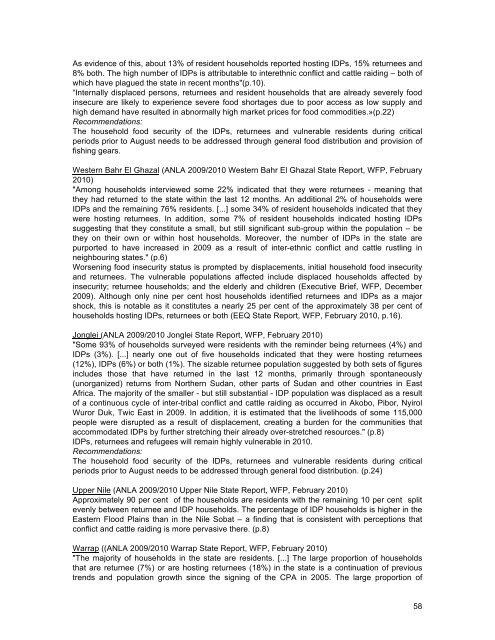SUDAN: Durable solutions elusive as southern IDPs return and ...
SUDAN: Durable solutions elusive as southern IDPs return and ...
SUDAN: Durable solutions elusive as southern IDPs return and ...
Create successful ePaper yourself
Turn your PDF publications into a flip-book with our unique Google optimized e-Paper software.
As evidence of this, about 13% of resident households reported hosting <strong>IDPs</strong>, 15% <strong>return</strong>ees <strong>and</strong><br />
8% both. The high number of <strong>IDPs</strong> is attributable to interethnic conflict <strong>and</strong> cattle raiding – both of<br />
which have plagued the state in recent months"(p.10).<br />
“Internally displaced persons, <strong>return</strong>ees <strong>and</strong> resident households that are already severely food<br />
insecure are likely to experience severe food shortages due to poor access <strong>as</strong> low supply <strong>and</strong><br />
high dem<strong>and</strong> have resulted in abnormally high market prices for food commodities.»(p.22)<br />
Recommendations:<br />
The household food security of the <strong>IDPs</strong>, <strong>return</strong>ees <strong>and</strong> vulnerable residents during critical<br />
periods prior to August needs to be addressed through general food distribution <strong>and</strong> provision of<br />
fishing gears.<br />
Western Bahr El Ghazal (ANLA 2009/2010 Western Bahr El Ghazal State Report, WFP, February<br />
2010)<br />
"Among households interviewed some 22% indicated that they were <strong>return</strong>ees - meaning that<br />
they had <strong>return</strong>ed to the state within the l<strong>as</strong>t 12 months. An additional 2% of households were<br />
<strong>IDPs</strong> <strong>and</strong> the remaining 76% residents. [...] some 34% of resident households indicated that they<br />
were hosting <strong>return</strong>ees. In addition, some 7% of resident households indicated hosting <strong>IDPs</strong><br />
suggesting that they constitute a small, but still significant sub-group within the population – be<br />
they on their own or within host households. Moreover, the number of <strong>IDPs</strong> in the state are<br />
purported to have incre<strong>as</strong>ed in 2009 <strong>as</strong> a result of inter-ethnic conflict <strong>and</strong> cattle rustling in<br />
neighbouring states." (p.6)<br />
Worsening food insecurity status is prompted by displacements, initial household food insecurity<br />
<strong>and</strong> <strong>return</strong>ees. The vulnerable populations affected include displaced households affected by<br />
insecurity; <strong>return</strong>ee households; <strong>and</strong> the elderly <strong>and</strong> children (Executive Brief, WFP, December<br />
2009). Although only nine per cent host households identified <strong>return</strong>ees <strong>and</strong> <strong>IDPs</strong> <strong>as</strong> a major<br />
shock, this is notable <strong>as</strong> it constitutes a nearly 25 per cent of the approximately 38 per cent of<br />
households hosting <strong>IDPs</strong>, <strong>return</strong>ees or both (EEQ State Report, WFP, February 2010, p.16).<br />
Jonglei (ANLA 2009/2010 Jonglei State Report, WFP, February 2010)<br />
"Some 93% of households surveyed were residents with the reminder being <strong>return</strong>ees (4%) <strong>and</strong><br />
<strong>IDPs</strong> (3%). [...] nearly one out of five households indicated that they were hosting <strong>return</strong>ees<br />
(12%), <strong>IDPs</strong> (6%) or both (1%). The sizable <strong>return</strong>ee population suggested by both sets of figures<br />
includes those that have <strong>return</strong>ed in the l<strong>as</strong>t 12 months, primarily through spontaneously<br />
(unorganized) <strong>return</strong>s from Northern Sudan, other parts of Sudan <strong>and</strong> other countries in E<strong>as</strong>t<br />
Africa. The majority of the smaller - but still substantial - IDP population w<strong>as</strong> displaced <strong>as</strong> a result<br />
of a continuous cycle of inter-tribal conflict <strong>and</strong> cattle raiding <strong>as</strong> occurred in Akobo, Pibor, Nyirol<br />
Wuror Duk, Twic E<strong>as</strong>t in 2009. In addition, it is estimated that the livelihoods of some 115,000<br />
people were disrupted <strong>as</strong> a result of displacement, creating a burden for the communities that<br />
accommodated <strong>IDPs</strong> by further stretching their already over-stretched resources." (p.8)<br />
<strong>IDPs</strong>, <strong>return</strong>ees <strong>and</strong> refugees will remain highly vulnerable in 2010.<br />
Recommendations:<br />
The household food security of the <strong>IDPs</strong>, <strong>return</strong>ees <strong>and</strong> vulnerable residents during critical<br />
periods prior to August needs to be addressed through general food distribution. (p.24)<br />
Upper Nile (ANLA 2009/2010 Upper Nile State Report, WFP, February 2010)<br />
Approximately 90 per cent of the households are residents with the remaining 10 per cent split<br />
evenly between <strong>return</strong>ee <strong>and</strong> IDP households. The percentage of IDP households is higher in the<br />
E<strong>as</strong>tern Flood Plains than in the Nile Sobat – a finding that is consistent with perceptions that<br />
conflict <strong>and</strong> cattle raiding is more perv<strong>as</strong>ive there. (p.8)<br />
Warrap ((ANLA 2009/2010 Warrap State Report, WFP, February 2010)<br />
"The majority of households in the state are residents. [...] The large proportion of households<br />
that are <strong>return</strong>ee (7%) or are hosting <strong>return</strong>ees (18%) in the state is a continuation of previous<br />
trends <strong>and</strong> population growth since the signing of the CPA in 2005. The large proportion of<br />
58
















